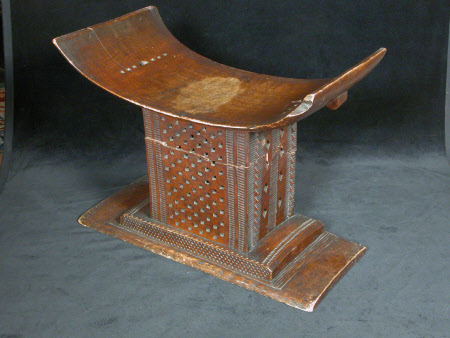Stool
Category
Furniture
Date
1870 - 1929
Materials
Hardwood
Measurements
45.5 x 60 x 31 cm
Place of origin
Ghana
Order this imageCollection
Wightwick Manor, West Midlands
NT 1288458
Summary
A carved hardwood (possibly mahogany) stool, probably Ghana, late 19th/early 20th century. The curved rectangular seat supported on a rectangular support with sides pierced with lozenges or squares, and between corners decorated with dog-tooth carving, and bands of horizontal lines. The stepped rectangular base with decorative notched carving in repeated patterns.
Full description
This stool has been catalogued as made ‘probably’ in Ghana because its support is slightly atypical of stools attributed to the region, which more often feature supports comprising a central free-standing pillar surrounded by four free-standing corner pillars, with open space between them. Others were made with supports modelled as humans or animals or were formed from interlaced scrolls. However, this stool’s curved seat, and stepped rectangular base are otherwise typical of stools made by Ghana’s Asante (Ashanti) craftsmen. A stool (Af1954,+23.3209) in the British Museum, with a similar support, has also been attributed to the Asante. The Asante are part of the larger and dominant Akan ethnic group of Ghana in West Africa. They established the Asante Kingdom in 1670, founding the capital at Kumasi in 1680. The Asante Kingdom’s territories were rich in resources – particularly gold – and, incorporated a coastline along the Gulf of Guinea which was a centre for the trade in gold, ivory and enslaved Africans. Attracted by this wealth, numerous European powers contested the area for trading rights and for almost a century, the Asante successfully resisted attempts at British occupation until they were defeated in 1900. In 1957, when independence was granted, the kingdom became part of the new dominion of Ghana. During the years of warfare, and then of British colonisation, much gold was stolen or looted from Ghana. In 1873-4, for instance, when the city was sacked by British troops in the Third Anglo-Ashanti War, numerous gold items and textiles were removed by Sir Garnet Wolseley’s (1833-1913) forces, while other gold pieces were paid to the British as settlement of the government’s indemnity claim. Some of these objects were sold at public auction in Cape Coast prior to the troop’s return to England; others were bought by Garrard & Co. in London for £11,000 and sold by them at auction in the spring of 1874. It is possible that stools – albeit without intrinsic value – were attained by the British in the same way. How this stool made its way into Wightwick’s collection is not clear. The stool occupies a special – sometimes sacred – place in Ghanaian society. The most powerful royal symbol of the Asante was the Golden Stool, which was meant to have descended from heaven at the Kingdom’s founding. Some stools were, of course, utilitarian objects found in every household. Others were associated with rites of passage and were given as gifts by, for example, a father to a child when it started to crawl or by a husband to a new bride. The stool also functions, however, as a sacred object and is believed by the Akan as being imbued with the spirit of its owner. When owned by a prestigious person, the stool is used in rituals of ancestor veneration. Lastly, it is a political symbol and the most important of any chief’s regalia. In Ghana, a new chief is ‘enstooled’ and, when he or she dies, the Akan say ‘the stool has fallen’. Thus, when, in 1900, Sir Frederick Mitchell Hodgson (1851-1925) demanded to sit on the Golden Stool, he sparked a violent uprising. The Golden Stool was hidden and was only found accidentally by labourers in 1921, after which the British gave an assurance that they would not seek to appropriate or take it. In 1935, the stool was used in the ceremony to crown Osei Tutu Ageyeman Prempeh II (1892-1970), the 14th King of the Ashanti.
Provenance
In 1937 Sir Geoffrey Mander and his wife Rosalie gifted Wightwick Manor, its contents and gardens to the National Trust. Sir Geoffrey and his family continued to occupy and manage Wightwick adding to the collection in collaboration with the National Trust. Sir Geoffrey died in 1962 but Lady Mander continued to live at Wightwick until her death in 1988. This stool was transferred to the National Trust on the death of Sir Geoffrey in 1962.
